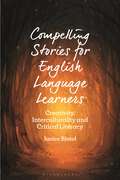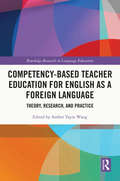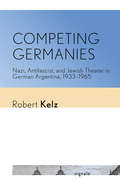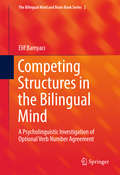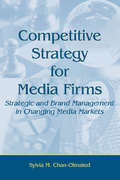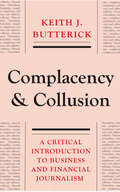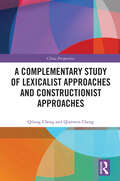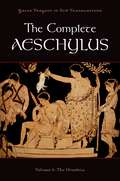- Table View
- List View
Compelling Stories for English Language Learners: Creativity, Interculturality and Critical Literacy
by Janice BlandThis book is a comprehensive and thorough introduction to children's and young adult literature in English language education. Reading is promoted as central to language education in order to experience perspectives from around the world, and the book demonstrates the many opportunities for teaching with compelling story, encouraging an active and engaged community of second language readers through challenging picturebooks, motivating graphic novels, dynamic plays, enchanting verse novels and compelling young adult fiction. Using many examples of literary texts that are well suited to the primary or secondary classroom, the book focuses on the advantages of deep reading and the vital importance of in-depth learning. In-depth learning is an approach that involves the students as motivated participants, working collaboratively and with empathy while preparing for and confronting the challenges of the 21st century. Illustrating the approach with a Deep Reading Framework based in research and theory, Janice Bland guides the reader to discover and learn how to make use of literary texts in a way that challenges students to become involved in interculturality, creativity and critical literacy. Throughout the book the emphasis is on an approach that puts the reader and language learner in the centre – not a study of literature but a study of how readers learn through compelling story.
Compendium Utopiarum, Teilband 1: Repertorien zur deutschen Literaturgeschichte, Band 8/1
by Michael WinterCompetency-based Language Teaching in Higher Education (Educational Linguistics #14)
by María Luisa Pérez CañadoSpanning the divide between the theory and praxis of competency-based teaching in tertiary language education, this volume contains invaluable practical guidance for the post-secondary sector on how to approach, teach, and assess competencies in Bologna-adapted systems of study. It presents the latest results of prominent European research projects, programs of pedagogical innovation, and thematically linked academic networks. Responding to a profound need for a volume addressing the practical aspects of the newly designed language degrees now being rolled out across Europe, this essential contribution pools the insights of a prestigious set of scholars, practitioners, and policy makers from diverse parts of Europe and the US. It will inform crucial decisions about instituting and evaluating competencies in a new generation of language studies programmes.
Competency-Based Teacher Education for English as a Foreign Language: Theory, Research, and Practice (Routledge Research in Language Education)
by Amber Yayin WangProviding a series of chapters, written by teacher educators in three continents, this edited volume explores the concepts, challenges, possibilities, and implementations of competency-based instruction for developing English competencies in English as a foreign language (EFL) contexts. Recent trends in education have emphasized the need to develop competencies that connect learning with real-life performances. This need has brought about a massive increase in the number of studies and scholarly works devoted to research into competency-based education. However, for teachers and learners of EFL, it is challenging to develop competencies for using a language that does not seem to connect with their real-life scenarios. The chapters apply the concept of competency-based instruction in different EFL contexts and are structured around three themes: Theory: current thoughts on theories of competency-based education Research: empirical research on competency-based teacher education Practice: integrating competency-based instruction into teacher education This book offers examples of competency-based EFL teacher education through both research and practical applications. In addition to the innovation in competency approaches, the inclusion of language learning in virtual environments offers a valuable resource for scholars, educators, researchers, and all those concerned with current and future education.
Competency-Based Teacher Education for English as a Foreign Language: Theory, Research, and Practice (Routledge Research in Language Education)
by Amber Yayin WangProviding a series of chapters, written by teacher educators in three continents, this edited volume explores the concepts, challenges, possibilities, and implementations of competency-based instruction for developing English competencies in English as a foreign language (EFL) contexts. Recent trends in education have emphasized the need to develop competencies that connect learning with real-life performances. This need has brought about a massive increase in the number of studies and scholarly works devoted to research into competency-based education. However, for teachers and learners of EFL, it is challenging to develop competencies for using a language that does not seem to connect with their real-life scenarios. The chapters apply the concept of competency-based instruction in different EFL contexts and are structured around three themes: Theory: current thoughts on theories of competency-based education Research: empirical research on competency-based teacher education Practice: integrating competency-based instruction into teacher education This book offers examples of competency-based EFL teacher education through both research and practical applications. In addition to the innovation in competency approaches, the inclusion of language learning in virtual environments offers a valuable resource for scholars, educators, researchers, and all those concerned with current and future education.
Competing Discourses: Perspective and Ideology in Language (Real Language Series)
by David LeeThis book discusses and explores the relationship between language and world view. David Lee presents recent research in linguistics, drawing together strands from a number of different areas of the subject: the nature of linguistic and conceptual categories, the role of metaphor in the everyday use of language, gender differentiation and social variation in speech.In this study, David Lee considers a broad range of issues in the light of two contrasting views on language. For much of its history, linguistics has been dominated by a tradition which sees individual languages as uniform, homogenous systems. However, there has always been an opposite view emphasising the complex tensions and cross-currents inherent in linguistic usage. This alternative perspective is explored in the analysis of a wide range of literary and non-literary texts: casual conversations, interviews, newspaper reports, official memoranda, television commercials and extracts from novels. The author describes how both spoken and written texts can be seen as the sites where tensions between "competing discourses", stemming from different social positions and perspectives, are illustrated.
Competing Discourses: Perspective and Ideology in Language (Real Language Series)
by David LeeThis book discusses and explores the relationship between language and world view. David Lee presents recent research in linguistics, drawing together strands from a number of different areas of the subject: the nature of linguistic and conceptual categories, the role of metaphor in the everyday use of language, gender differentiation and social variation in speech.In this study, David Lee considers a broad range of issues in the light of two contrasting views on language. For much of its history, linguistics has been dominated by a tradition which sees individual languages as uniform, homogenous systems. However, there has always been an opposite view emphasising the complex tensions and cross-currents inherent in linguistic usage. This alternative perspective is explored in the analysis of a wide range of literary and non-literary texts: casual conversations, interviews, newspaper reports, official memoranda, television commercials and extracts from novels. The author describes how both spoken and written texts can be seen as the sites where tensions between "competing discourses", stemming from different social positions and perspectives, are illustrated.
Competing Germanies: Nazi, Antifascist, and Jewish Theater in German Argentina, 1933–1965 (Signale: Modern German Letters, Cultures, and Thought)
by Robert KelzFollowing World War II, German antifascists and nationalists in Buenos Aires believed theater was crucial to their highly politicized efforts at community-building, and each population devoted considerable resources to competing against its rival onstage. Competing Germanies tracks the paths of several stage actors from European theaters to Buenos Aires and explores how two of Argentina's most influential immigrant groups, German nationalists and antifascists (Jewish and non-Jewish), clashed on the city's stages. Covered widely in German- and Spanish-language media, theatrical performances articulated strident Nazi, antifascist, and Zionist platforms. Meanwhile, as their thespian representatives grappled onstage for political leverage among emigrants and Argentines, behind the curtain, conflicts simmered within partisan institutions and among theatergoers. Publicly they projected unity, but offstage nationalist, antifascist, and Zionist populations were rife with infighting on issues of political allegiance, cultural identity and, especially, integration with their Argentine hosts.Competing Germanies reveals interchange and even mimicry between antifascist and nationalist German cultural institutions. Furthermore, performances at both theaters also fit into contemporary invocations of diasporas, including taboos and postponements of return to the native country, connections among multiple communities, and forms of longing, memory, and (dis)identification. Sharply divergent at first glance, their shared condition as cultural institutions of emigrant populations caused the antifascist Free German Stage and the nationalist German Theater to adopt parallel tactics in community-building, intercultural relationships, and dramatic performance.Its cross-cultural, polyglot blend of German, Jewish, and Latin American studies gives Competing Germanies a wide, interdisciplinary academic appeal and offers a novel intervention in Exile studies through the lens of theater, in which both victims of Nazism and its adherents remain in focus.
Competing Motivations in Grammar and Usage
This volume examines the conflicting factors that shape the content and form of grammatical rules in language usage. Speakers and addressees need to contend with these rules when expressing themselves and when trying to comprehend messages. For example, there are on-going competitions between the speaker's interests and the addressee's needs, or between constraints imposed by grammar and those imposed by online processing. These competitions influence a wide variety of systems, including case marking, agreement and word order, politeness forms, lexical choices, and the position of relative clauses. Chapters in the book analyse grammar and usage in adult language as well as first and second language acquisition, and the motivations that drive historical change. Several of the chapters seek explanations for the competitions involved, based on earlier accounts including the Competition Model, Natural Morphology, the functional-typological tradition, and Optimality Theory. The book will be of interest to linguists from a wide variety of backgrounds, particularly those interested in psycholinguistics, historical linguistics, philosophy of language, and language acquisition, from advanced undergraduate level upwards.
Competing Structures in the Bilingual Mind: A Psycholinguistic Investigation of Optional Verb Number Agreement (The Bilingual Mind and Brain Book Series #2)
by Elif BamyacıThis volume combines psycholinguistic experiments with typological investigations in order to provide a comprehensive exploration of the linguistic structure of verb-number agreement in bilingual speakers, with a particular focus on the Turkish language. It takes as its starting point the question of which linguistic structures pose difficulties for bilingual speakers, and then proceeds to evaluate the question by using the interface phenomenon of optional verb number agreement. In doing so, this volume investigates how the bilingual mind handles grammatical structures that demand high processing sources, working towards a processing-based linguistic framework for the bilingual mind. Beginning with a thorough survey of the current research of the interface phenomenon in the bilingual mind, the volume then proceeds to present two separate studies on each linguistic interface type, namely semantics-syntax interface and syntax-pragmatics interface, thus filling a number of gaps in the bilingualism research with regards to the interface phenomenon The results and conclusions of these studies are then integrated with current knowledge and research from the field within a theoretical and processing-based framework in order to explore new psycholinguistic insights for the bilingual mind, specifically the conclusion that the grammar of bilingual speakers is shaped according to cross linguistic tendencies. Ultimately, it provides a unified account and a comprehensive conclusion regarding the non-native-like patterns in grammar of bilingual speakers. Serving as a fascinating and timely resource, Competing Structures in the Bilingual Mind: An Investigation of Optional Verb Number Agreement will appeal to bilingualism researchers, clinical linguists, cognitive scientists, experimental linguists, and any linguist specializing in Turkic or Altaic languages.
Competing Visions of World Order: Global Moments and Movements, 1880s-1930s (Palgrave Macmillan Transnational History Series)
by Sebastian Conrad Dominic SachsenmaierBringing together scholars from around the world, this first book in the Palgrave Macmillan Transnational History Series raises the question of how we can get away from the contemporary language of globalization, so as to identify meaningful, global ways of defining historical events and processes in the late Nineteenth and Twentieth centuries.
Competition and Variation in Natural Languages: The Case for Case (ISSN)
by Mengistu Amberber Helen De HoopThis volume combines different perspectives on case-marking: (1) typological and descriptive approaches of various types and instances of case-marking in the languages of the world as well as comparison with languages that express similar types of relations without morphological case-marking; (2) formal analyses in different theoretical frameworks of the syntactic, semantic, and morphological properties of case-marking; (3) a historical approach of case-marking; (4) a psycholinguistic approach of case-marking. Although there are a number of publications on case related issues, there is no volume such as the present one, which exclusively looks at case marking, competition and variation from a cross-linguistic perspective and within the context of different contemporary theoretical approaches to the study of language. In addition to chapters with broad conceptual orientation, the volume offers detailed empirical studies of case in a number of diverse languages including: Amharic, Basque, Dutch, Hindi, Japanese, Kuuk Thaayorre, Malagasy and Yurakaré.The volume will be of interest to researchers and advanced students in the cognitive sciences, general linguistics, typology, historical linguistics, formal linguistics, and psycholinguistics. The book will interest scholars working within the context of formal syntactic and semantic theories as it provides insight into the properties of case from a cross-linguistic perspective. The book also will be of interest to cognitive scientists interested in the relationship between meaning and grammar, in particular, and the human mind's capacity in the mapping of meaning onto grammar, in general.
Competition in Inflection and Word-Formation (Studies in Morphology #5)
by Franz Rainer Francesco Gardani Wolfgang U. Dressler Hans Christian LuschützkyThis is the first volume specifically dedicated to competition in inflection and word-formation, a topic that has increasingly attracted attention. Semantic categories, such as concepts, classes, and feature bundles, can be expressed by more than one form or formal pattern. This departure from the ideal principle "one form – one meaning" is particularly frequent in morphology, where it has been treated under diverse headings, such as blocking, Elsewhere Condition, Pāṇini's Principle, rivalry, synonymy, doublets, overabundance, suppletion and other terms. Since these research traditions, despite the heterogeneous terminology, essentially refer to the same underlying problems, this volume unites the phenomena studied in this field of linguistic morphology under the more general heading of competition.The volume features an extensive state of the art report on the subject and 11 research papers, which represent various theoretical approaches to morphology and address a wide range of aspects of competition, including morphophonology, lexicology, diachrony, language contact, psycholinguistics, sociolinguistics and language acquisition.
Competitive Strategy for Media Firms: Strategic and Brand Management in Changing Media Markets (Routledge Communication Series)
by Sylvia M. Chan-OlmstedCompetitive Strategy for Media Firms introduces the concepts and analytical frameworks of strategic and brand management, and illustrates how they can be adapted according to the characteristics of distinct media products. Working from the premise that all media firms must strategize in response to the continuing evolution of new media, author Sylvia M. Chan-Olmsted offers applications of common business approaches to the products and components of the electronic media industry, and provides empirical examinations of broadcast, multichannel media, enhanced television, broadband communications, and global media conglomerate markets. This insightful and timely volume provides a thorough review of current concepts and industry practices, and serves as an essential primer for the application of business models in media contexts. As a realistic and integrated approach to media industry studies, this volume has much to offer researchers, scholars, and graduate students in media economics and management, and will be an important reference for industry practitioners.
Competitive Strategy for Media Firms: Strategic and Brand Management in Changing Media Markets (Routledge Communication Series)
by Sylvia M. Chan-OlmstedCompetitive Strategy for Media Firms introduces the concepts and analytical frameworks of strategic and brand management, and illustrates how they can be adapted according to the characteristics of distinct media products. Working from the premise that all media firms must strategize in response to the continuing evolution of new media, author Sylvia M. Chan-Olmsted offers applications of common business approaches to the products and components of the electronic media industry, and provides empirical examinations of broadcast, multichannel media, enhanced television, broadband communications, and global media conglomerate markets. This insightful and timely volume provides a thorough review of current concepts and industry practices, and serves as an essential primer for the application of business models in media contexts. As a realistic and integrated approach to media industry studies, this volume has much to offer researchers, scholars, and graduate students in media economics and management, and will be an important reference for industry practitioners.
Compiling Texts in Eighteenth-Century Britain: Mediating the Scottish Enlightenment (Palgrave Studies in the Enlightenment, Romanticism and Cultures of Print)
by Rebeca Araya AcostaThis book argues that the act of compiling texts together into collections in the eighteenth century is politically and epistemologically significant. Focusing on the reception of Scottish Enlightenment ideas, and ranging across an Edinburgh print shop, an excluded religious community in the North of England, and the story worlds of novelists and poets, the study reveals compilation to be a politically resistant activity: it challenged centralizing and homogenizing tendencies within the growing British empire in the latter half of the eighteenth century and actively built counternarratives. Rebeca Araya Acosta offers a fresh view of eighteenth-century literary transaction and shows how practices of compilation in the period were more diversified and had a far greater impact on readers than their modern descendants.
Complacency: Classics and Its Displacement in Higher Education (Critical Antiquities)
by John T. HamiltonA critical reflection on complacency and its role in the decline of classics in the academy. In response to philosopher Simon Blackburn’s portrayal of complacency as a vice that impairs university study at its core, John T. Hamilton examines the history of complacency in classics and its implications for our contemporary moment. The subjects, philosophies, and literatures of ancient Greece and Rome were once treated as the foundation of learning, with everything else devolving from them. Hamilton investigates what this model of superiority, derived from the golden age of the classical tradition, shares with the current hegemony of mathematics and the natural sciences. He considers how the qualitative methods of classics relate to the quantitative positivism of big data, statistical reasoning, and presumably neutral abstraction, which often dismiss humanist subjectivity, legitimize self-sufficiency, and promote a fresh brand of academic complacency. In acknowledging the reduced status of classics in higher education today, he questions how scholarly striation and stagnation continue to bolster personal, ethical, and political complacency in our present era.
Complacency: Classics and Its Displacement in Higher Education (Critical Antiquities)
by John T. HamiltonA critical reflection on complacency and its role in the decline of classics in the academy. In response to philosopher Simon Blackburn’s portrayal of complacency as a vice that impairs university study at its core, John T. Hamilton examines the history of complacency in classics and its implications for our contemporary moment. The subjects, philosophies, and literatures of ancient Greece and Rome were once treated as the foundation of learning, with everything else devolving from them. Hamilton investigates what this model of superiority, derived from the golden age of the classical tradition, shares with the current hegemony of mathematics and the natural sciences. He considers how the qualitative methods of classics relate to the quantitative positivism of big data, statistical reasoning, and presumably neutral abstraction, which often dismiss humanist subjectivity, legitimize self-sufficiency, and promote a fresh brand of academic complacency. In acknowledging the reduced status of classics in higher education today, he questions how scholarly striation and stagnation continue to bolster personal, ethical, and political complacency in our present era.
Complacency and Collusion: A Critical Introduction to Business and Financial Journalism
by Keith J. ButterickComplacency and Collusion focuses on the practice of financial and business journalism, giving compelling explanations for why big business needs the press and why the press needs big business.*BR**BR*The growing passivity and changing bias of Western journalists is widely acknowledged. Across the media, in newspapers, TV, media and the internet, journalism is increasingly hollowed out by writers who are no longer gathering news but rather churning out unsourced information, PR texts and online snippets. Behind this dubious practice is an increasingly invested corporate sector whose stake in the mainstream media as a mouthpiece has exponentially increased in the last few decades.*BR**BR*The book cuts through the misreporting that has occurred since the financial crisis and makes clear the inadequacies of articles in prestigious papers and magazines, such as the Economist and Financial Times. It reflects on what the growth and spread of complacent corporate journalism will mean for the future of a free media.
Complacency and Collusion: A Critical Introduction to Business and Financial Journalism
by Keith J. ButterickComplacency and Collusion focuses on the practice of financial and business journalism, giving compelling explanations for why big business needs the press and why the press needs big business.*BR**BR*The growing passivity and changing bias of Western journalists is widely acknowledged. Across the media, in newspapers, TV, media and the internet, journalism is increasingly hollowed out by writers who are no longer gathering news but rather churning out unsourced information, PR texts and online snippets. Behind this dubious practice is an increasingly invested corporate sector whose stake in the mainstream media as a mouthpiece has exponentially increased in the last few decades.*BR**BR*The book cuts through the misreporting that has occurred since the financial crisis and makes clear the inadequacies of articles in prestigious papers and magazines, such as the Economist and Financial Times. It reflects on what the growth and spread of complacent corporate journalism will mean for the future of a free media.
Complementarity Between Lexis and Grammar in the System of Person: A Systemic Typological Approach (China Perspectives)
by Pin WangThis book investigates the lexico-grammatical complementarity in language in its construal of person as a semantic system. Given the vast and wide spectrum of resources for expressing distinctions in the assignment of person roles in language, this book presents person-related system networks covering a rich range of semantic features. It also studies the system of person in relation to other major semantic systems instead of regarding it as one isolated component of language parallel to gender, number, case, etc. Systemic features of person are in turn realized by lexicogrammar, whose components, lexis and grammar form a relationship of complementarity in the process of transforming human experience into meaning. Person-related meaning can be either realized by lexical means, i.e. entity, process, quality, or grammatical means, i.e. pronouns, clitics, affixes, zero forms. Besides, such meaning is also found to be realized at some indeterminate areas along the lexis-grammar continuum. A special feature of this book is that it observes the lexicalization and grammaticalization of person based on evidence from a variety of languages. Readers will be presented a comprehensive look into the meaning of person and will be encouraged to reflect on its realization in their own languages.
Complementarity Between Lexis and Grammar in the System of Person: A Systemic Typological Approach (China Perspectives)
by Pin WangThis book investigates the lexico-grammatical complementarity in language in its construal of person as a semantic system. Given the vast and wide spectrum of resources for expressing distinctions in the assignment of person roles in language, this book presents person-related system networks covering a rich range of semantic features. It also studies the system of person in relation to other major semantic systems instead of regarding it as one isolated component of language parallel to gender, number, case, etc. Systemic features of person are in turn realized by lexicogrammar, whose components, lexis and grammar form a relationship of complementarity in the process of transforming human experience into meaning. Person-related meaning can be either realized by lexical means, i.e. entity, process, quality, or grammatical means, i.e. pronouns, clitics, affixes, zero forms. Besides, such meaning is also found to be realized at some indeterminate areas along the lexis-grammar continuum. A special feature of this book is that it observes the lexicalization and grammaticalization of person based on evidence from a variety of languages. Readers will be presented a comprehensive look into the meaning of person and will be encouraged to reflect on its realization in their own languages.
A Complementary Study of Lexicalist Approaches and Constructionist Approaches (China Perspectives)
by Qilong Cheng Qianwen ChengThis book presents a complementary study of lexicalist approaches and constructionist approaches in linguistics. Specifi c topics discussed include different versions of semantic roles, predicate decomposition, event structures, argument realizations, and cognitive construction grammars. For decades, the relationship between certain concepts and constructions along with related issues of verb-construction associations have been perennially taxing for both lexicalist and constructionist approaches alike. Indeed, in Chinese, unmatched verb-construction associations and the much richer alternate realizations pose very diffi cult problems. Based on a comparative study, the authors make an attempt to account for the possible correspondence between the delicacy of argument setting and the principles of their realization. They also account for the integration of construction with verbs in terms of their coherent conceptual content. The resultant newly developed model throws new light on these thorny Chinese problems. The book will appeal to scholars and students studying cognitive linguistics, cognitive semantics, computational linguistics, and also natural language processing. The book also brings up some new analysis of Chinese data for both researchers and learners of Modern Chinese.
A Complementary Study of Lexicalist Approaches and Constructionist Approaches (China Perspectives)
by Qilong Cheng Qianwen ChengThis book presents a complementary study of lexicalist approaches and constructionist approaches in linguistics. Specifi c topics discussed include different versions of semantic roles, predicate decomposition, event structures, argument realizations, and cognitive construction grammars. For decades, the relationship between certain concepts and constructions along with related issues of verb-construction associations have been perennially taxing for both lexicalist and constructionist approaches alike. Indeed, in Chinese, unmatched verb-construction associations and the much richer alternate realizations pose very diffi cult problems. Based on a comparative study, the authors make an attempt to account for the possible correspondence between the delicacy of argument setting and the principles of their realization. They also account for the integration of construction with verbs in terms of their coherent conceptual content. The resultant newly developed model throws new light on these thorny Chinese problems. The book will appeal to scholars and students studying cognitive linguistics, cognitive semantics, computational linguistics, and also natural language processing. The book also brings up some new analysis of Chinese data for both researchers and learners of Modern Chinese.
The Complete Aeschylus: Volume I: The Oresteia (Greek Tragedy in New Translations)
by AeschylusBased on the conviction that only translators who write poetry themselves can properly re-create the celebrated and timeless tragedies of Aeschylus, Sophocles, and Euripides, the Greek Tragedy in New Translations series offers new translations that go beyond the literal meaning of the Greek in order to evoke the poetry of the originals. Aeschylus' Oresteia, the only ancient tragic trilogy to survive, is one of the great foundational texts of Western culture. It begins with Agamemnon, which describes Agamemnon's return from the Trojan War and his murder at the hands of his wife Clytemnestra, continues with her murder by their son Orestes in Libation Bearers, and concludes with Orestes' acquittal at a court founded by Athena in Eumenides. The trilogy thus traces the evolution of justice in human society from blood vengeance to the rule of law, Aeschylus' contribution to a Greek legend steeped in murder, adultery, human sacrifice, cannibalism, and endless intrigue. This new translation is faithful to the strangeness of the original Greek and to its enduring human truth, expressed in language remarkable for poetic intensity, rich metaphorical texture, and a verbal density that modulates at times into powerful simplicity. The translation's precise but complicated rhythms honor the music of the Greek, bringing into unforgettable English the Aeschylean vision of a world fraught with spiritual and political tensions.
